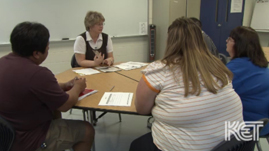Teachers' Domain - Digital Media for the Classroom and Professional Development
User: Preview



Adult education instructor Kay Combs prepares students for a reading comprehension lesson. The lesson teaches students to use prediction and inference as they read.
These resources are part of KET's Reading Instructional Strategies collection.
Prediction and inference are excellent ways to boost reading comprehension. A reader may not have to know the exact meaning of every word on the page to have a good sense of the meaning of the text as a whole. In this video, adult education instructor Kay Combs introduces a lesson on prediction and inference by explaining the purpose of the lesson and presenting the reading material.
Describing a lesson explicitly to students is an important part of pre-teaching. Preparing students for the techniques you will use may go a long way towards putting them at ease and increasing their willingness to participate. This is especially true for a lesson in predicting and inferring the meaning of a text. Students should understand that, even if they don’t turn out to be correct, making predictions can help them understand what they are reading.
Also, in order to practice prediction and inference, students need to be aware of the strategy from the moment they encounter a text. Examining the title, photos, subtitles, captions, and author information is an important part of predicting what lies ahead for the reader.
 Loading Standards
Loading Standards